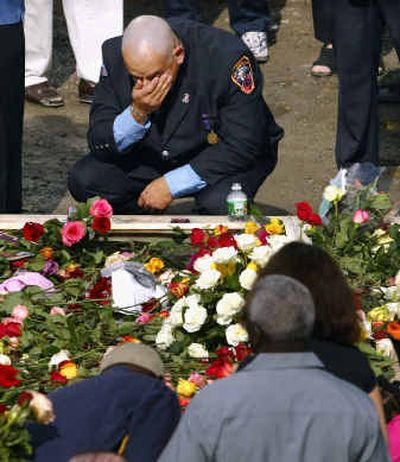Persistent health problems part of attacks’ impact

HACKENSACK, N.J. – The terrorist attack on Sept. 11, 2001, caused a new respiratory syndrome – World Trade Center cough – which affected thousands of firefighters and forced more than 300 to end their careers early.
The noxious smoke resulted in an increase in asthma, wheezing and shortness of breath among those who escaped the towers, were working nearby, or rushed to the scene to help.
Thousands visited hospital emergency rooms in the aftermath, with injuries that included broken bones, burns and inhalation problems.
But the accident rate during the weeks of cleanup work at ground zero was remarkably low.
The attack resulted in a variety of mental health problems, from post-traumatic stress disorder to an increased use of alcohol and drugs.
That was the summary of the government’s chief accounting office, in testimony Wednesday to Congress on health effects in the aftermath of the World Trade Center attack.
The full health impact is still unknown, said Janet Heinrich, who directs the Government Accountability Office’s division on public-health issues and health care.
“Concern about potential long-term effects on people affected by the attack remains,” she said, because monitoring programs – many of which lose their federal funding in 2008 – may not last long enough to capture information on cancers or chronic diseases, which can take years to develop.
The GAO examined the studies published about the people who escaped the towers, lived in the vicinity, or responded to the emergency. It estimated that 16,300 to 18,800 people were in the complex at the time of the attacks, and that 40,000 people participated in the rescue or cleanup effort. Almost 3,000 died in the attacks.
Their summary included these highlights:
•More than 7,000 people sought emergency-room care, mostly for inhalation injuries, broken bones, burns and eye injuries, at hospitals in New York and New Jersey.
•During the 10-month cleanup, those who worked at the site logged 3.7 million work hours, but only 57 serious injuries resulting in lost work days – a rate significantly lower than at similarly dangerous work sites.
•More than 300 firefighters developed “WTC cough,” described as a persistent cough, usually accompanied by gastro-esophageal reflux. Similar respiratory effects were found among carpenters, clean-up workers, federal civilian employees, heavy equipment operators, ironworkers, and mechanics who worked at the site.
•Children who lived within a five-mile radius of the World Trade Center had a higher number of asthma-related doctor visits than before.
•Women who were pregnant at the time of the attack did not go into labor earlier than expected or have smaller babies than average.
But a higher rate of babies born to women who were in or near the trade center were “small for gestational age” compared with those who weren’t.
•The rates of post-traumatic stress disorder were higher in Manhattan than in the rest of the country.
A survey of New York fourth- to 12th-graders six months after the attack found that 10 percent had symptoms consistent with PTSD.
•Almost one-third of the people surveyed in New York, New Jersey and Connecticut said they were using more alcohol, tobacco and marijuana in the three months after the attack, and this continued at six months.
Almost three years after the attack, some children and widows still have difficulty coping with their daily responsibilities.